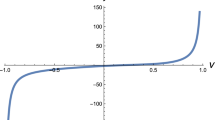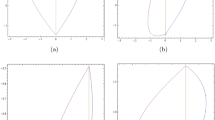Summary
The method of stationary phase, usually adopted to evaluate oscillatory integrals, such as Feynman's path integrals, leads to difficulties when the integrand phase—which is controlled by the position of a point in a space of parameters—exhibits a configuration characterized by the coalescing of several dominant saddle points into one. A method is proposed to deal with such a pathological occurrence and the case of two merging saddle points is thoroughly discussed.
Riassunto
Il metodo della fase stazionaria, utilizzato, in generale, per calcolare integrali oscillanti quali gli integrali di cammino di Feynman, incontra difficoltà di applicazione quando la fase dell'integrando— che è controllata dalla posizione di un punto nello spazio dei parametri— presenta una configurazione caratterizzata dal fatto che diversi punti a sella dominanti si fondono in un punto solo. Si propone qui un metodo per trattare tale situazione singolare e, in particolare, si analizza in dettaglio il caso di due punti a sella coalescenti.
Similar content being viewed by others
References
S. Albeverio andR. Høeg-Krohn:Inventiones Math.,40, 59 (1977).
A. S. Wightman:Phys. Rev.,101, 860 (1956).
S. W. Hawking:Commun. Math. Phys.,55, 133 (1977).
R. Balian andC. de Dominicis:Ann. Phys. (N. Y.),62, 229 (1971).
J. J. Duistermaat:Commun. Pure Appl. Math.,27, 207 (1974).
V. I. Arnol'd:Russ. Math. Surveys,28, 19 (1976).
V. P. Maslov:Theor. Math. Phys. (USSR),2–3, 21 (1970).
E. Brezin, J. C. Le Guillou andJ. Zinn-Justin: inPhase Transitions and Critical Phenomena, Vol.6, edited byC. Domb andM. S. Green (Academic Press, London, 1976), Chapt. 3.
M. Creutz andB. Freedman:Ann. Phys. (N.Y.),132, 427 (1981).
N. Wiener:J. Math. Phys. (N. Y.),2, 131 (1923);Acta Math.,55, 117 (1930).
E. Nelson:J. Math. Phys. (N. Y.),5, 332 (1964).
S. Albeverio, Ph. Blanchard andR. Høeg-Krohn:Commun. Math. Phys.,83, 49 (1982);M. C. Gutzwiller: inPath Integrals, edited byG. J. Papadopoulos andJ. T. Devreese (Plenum Press, New York, N. Y., 1978), p. 163.
J. Milnor:Morse Theory (Princeton University Press, Princeton, N.J., 1973).
B. Malgrange:Springer Lect. Notes Phys.,126, 170 (1980;Ann. Sci. Ec. Norm. Sup., 4ème Série,7, 405 (1974).
N. Levinson:Duke Math. J.,28, 345 (1961);J. Dieudonné:Calcul Infinitesimal (Hermann, Paris, 1968).
N. Bleistein:J. Math. Mech.,17, 533 (1967).
A. Erdélyi, W. Magnus andF. Oberhettinger:Higher Transcendental Functions, Vol.1 (McGraw-Hill, New York, N. Y., 1955), Sect. 5.
Author information
Authors and Affiliations
Rights and permissions
About this article
Cite this article
Axel, F., Rasetti, M. Path integrals with coalescent dominant saddle points. Nuov Cim B 87, 157–175 (1985). https://doi.org/10.1007/BF02721536
Received:
Published:
Issue Date:
DOI: https://doi.org/10.1007/BF02721536




